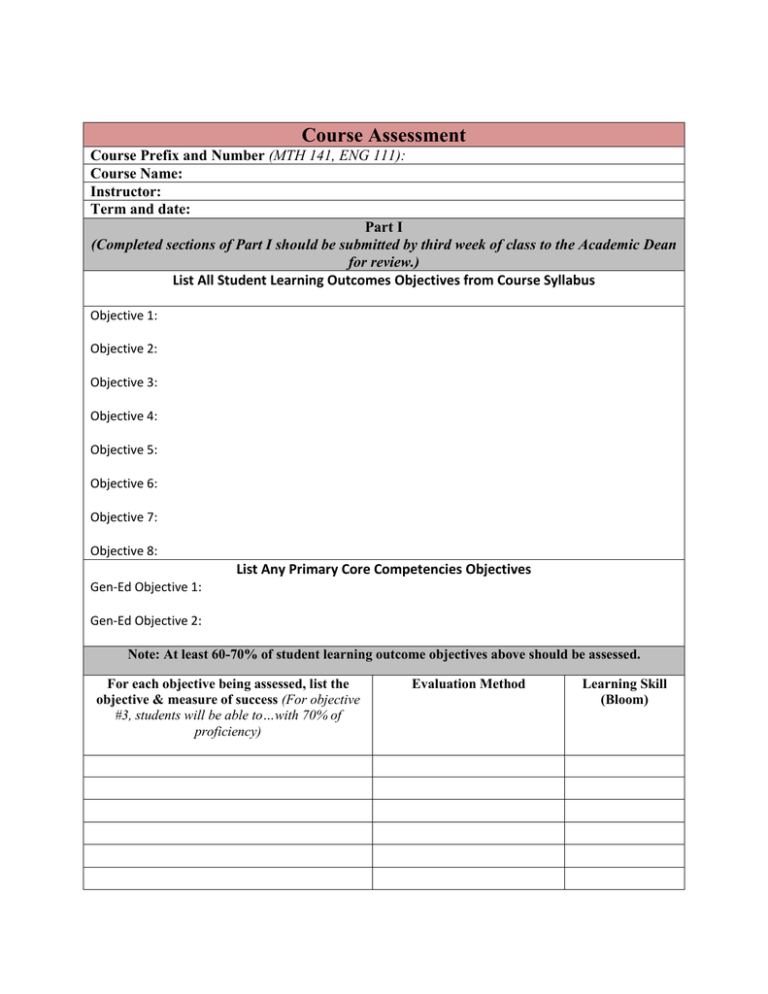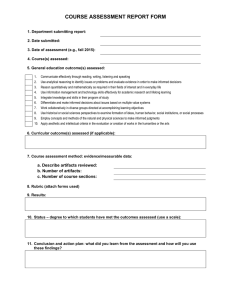Course Assessment
advertisement

Course Assessment Course Prefix and Number (MTH 141, ENG 111): Course Name: Instructor: Term and date: Part I (Completed sections of Part I should be submitted by third week of class to the Academic Dean for review.) List All Student Learning Outcomes Objectives from Course Syllabus Objective 1: Objective 2: Objective 3: Objective 4: Objective 5: Objective 6: Objective 7: Objective 8: List Any Primary Core Competencies Objectives Gen-Ed Objective 1: Gen-Ed Objective 2: Note: At least 60-70% of student learning outcome objectives above should be assessed. For each objective being assessed, list the objective & measure of success (For objective #3, students will be able to…with 70% of proficiency) Evaluation Method Learning Skill (Bloom) Actions Implemented: What specific actions or new initiatives (if any) did you implement this year to improve your course? Why? General Education (Core Competencies): (1) Oral Communication, (2) Written Communication, (3) Critical Thinking,(4) Scientific Reasoning, (5) Quantitative Reasoning, and (6) Information Literacy Sample Generic Grid for Mapping the Assessment (Make sure your grid shows a good balance of outcomes and enough attention to higher learning skills.) Measure of success Objective 2: Students will …with 70% proficiency Objective 4: Students will … 80% of the time Objective 5: Students will …with 75% proficiency Objective 8: Students will …with 95% accuracy Evaluation Method Common questions 1-8 on Test 1 Learning Skill (Bloom) Knowledge Common questions 20-35 on Test 2 Knowledge 30-minute exam essay question, scored by rubric Scored by rubric Comprehension, analysis Comprehension, analysis, synthesis Evaluation Method: (rubric, embedded test questions, project, lab test, journal, certification test, portfolio) Bloom’s Taxonomy: (Note: higher level courses should have higher level thinking.) Knowledge: Recall of previously learned facts Words to use to assess recall: identify, define; describe, state, label, list, match, reproduce Comprehension: Understanding what is meant Words to use to assess comprehension: give examples of, classify, explain, describe, summarize, outline, trace Application: Use of previous knowledge to approach new situations or problems Words to use to assess application: predict, construct, prepare, produce, show, use, implement, design, show how Analysis: Separate into component parts Words to use to assess analysis: list the components parts of, break down, differentiate, distinguish, diagram, illustrate, outline, subdivide, interpret, compare/contrast Synthesis: Putting elements together so as to form a new concept Words to use to assess synthesis: adapt, design, compare/contrast, categorize, compile, assemble, rearrange, give evidence for, give reasons for, formulate, infer, generate, integrate, plan Evaluation: Judging by criteria Words to use to assess evaluation: Develop criteria for, rank, prioritize, explain why you agree or disagree, which is better, appraise, defend, judge, compare and contrast by criteria, review. PART II (Completed sections of Part II should be submitted by End-of-Term to the Academic Dean. The Dean will review and send to Director of Assessment & IR) Findings/Results: (List each objective number that was assessed and results): Objective __: Objective __: Objective __: Objective __: Objective __: Objective __: Objective __: Objective __: Analysis & Evidence of Improvement: (To what factors for each objective did you attribute your findings/results to? Overall, what evidence of course improvement based on your analysis of results did you find?) Objective __: Objective __: Objective __: Objective __: Objective __: Objective __: Objective __: Objective __: Action Taken to Modify Course to Improve Student Learning (based on results) and Why? (What will you do differently? Describe how the results obtained from the assessment will be used to improve student learning for objectives assessed. Why?) Objective __: Objective __: Objective __: Objective __: Objective __: Objective __: Objective __: Objective __: Summary of Course Changes/Needs to Improve Student Learning: Changes made or needs for the course are the following: (1) Teaching methods (more homework, additional exercises, more emphasis on teamwork, providing review sessions, more hands-on, etc.) changes and/or changes to course syllabi: (2) Resources needed (equipment, software, student activities support for speakers, field trips, new textbook, tutors, etc.): (3) Policy change(s) (attendance, course pre-requisites, etc) that are needed to improve on student learning outcomes:




